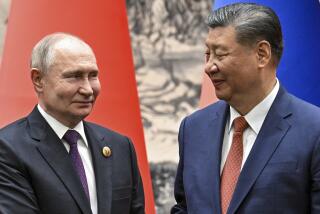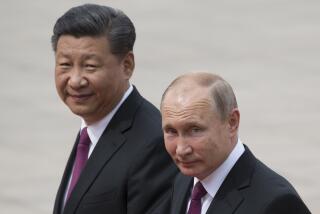China and India Launch New Era of Cooperation : Diplomacy: After three decades, they agree on trade and technology issues. But border differences remain.
- Share via
NEW DELHI — China and India ushered in a new era of cooperation Monday between the two most populous nations on the globe, endorsing a statement that made final their new partnerships in everything from border trade and regional diplomacy to outer space and the “new world order.”
Their joint communique, the result of the Chinese leadership’s first official visit to India in more than three decades, was announced as China’s Premier Li Peng received full military honors outside New Delhi’s grand presidential palace during a departure ceremony that ended a watershed, six-day visit between Li and Indian Prime Minister P. V. Narasimha Rao.
During their week of meetings, Li and Rao, who represent combined populations of more than 2 billion, made little progress on a contentious border dispute resulting from their 1962 war--a claim by New Delhi that Beijing continues to occupy illegally a belt of strategic Himalayan territory between the Indian state of Kashmir and western China. India has demanded that large tracts in the region occupied by the Chinese during the war be returned before it will sign any border agreement.
But all the two leaders managed to agree to during the past week was to temporarily ignore the issue while building better relations in trade, technological cooperation and regional security threats.
“There hasn’t been much progress on the border (dispute), but we didn’t expect it, either,” Rao told reporters. “But we’re making progress on all other fronts. . . . On the whole, it was a good visit.”
Most analysts concluded that the new agreements are groundbreaking and equally beneficial for both of the vast yet impoverished nations, although the Chinese emerged with a big prize: a key paragraph in Monday’s communique in which India all but endorsed China’s policy in Tibet, an autonomous region forcibly occupied by the Chinese army in 1951 and repressed by Beijing.
More than 100,000 Tibetans who fled the often-violent Chinese crackdowns are now refugees in India. Their leader, the Dalai Lama, who won the 1989 Nobel Peace Prize, maintains his spiritual base and a government-in-exile in the northern Indian city of Dharamsala. Throughout decades of Communist rule in Tibet, the Dalai Lama and his exiled followers have sought India’s political support for an independent Tibet.
But on Monday, India not only “reiterated its longstanding and consistent position that Tibet is an autonomous region of China,” it also stressed in the communique that New Delhi “does not allow Tibetans to engage in anti-China political activities in India.”
Further, New Delhi’s police riot squads backed those words with deeds in the past week, tear-gassing, beating and jailing hundreds of Tibetan men, women and children who gathered in nonviolent, anti-Communist demonstrations every day that Li and his delegation were in the Indian capital.
So repressive were the riot police at the Tibetan demonstrations that an Indian Supreme Court justice, in ruling that hundreds of Tibetans had been jailed illegally during the operation last week, stressed that the courts would not permit the government to use such excessive force “simply to protect a foreign dignitary.”
In an editorial applauding the court ruling, a national English-language newspaper, the Indian Express, denounced what it called a “shocking crackdown” and sharply criticized the Rao government for its “excessive anxiety to avoid embarrassment to the Chinese premier.”
“Although police often lose a sense of proportion, it is difficult to believe that they would have come down so heavily on peaceful demonstrators in the present case without explicit instructions from the higher authorities,” the editorial stated. “The government clearly thinks nothing of infringement of the democratic right of peaceful protest.”
Nonetheless, Rao and Li, who helped preside over the brutal June, 1989, military crackdown on pro-democracy protesters at Tian An Men Square in Beijing, included in their communique on Monday an agreement that “the universal realization of human rights and fundamental freedoms for the whole of mankind should be safeguarded and promoted.”
But in defining “human rights,” they placed the issue in a Third World context, reflecting much of the tone of the six days of meetings. “For the vast number of developing countries, the right to subsistence and development is a basic human right,” they declared, stressing that both countries condemn richer nations that use human rights as an excuse to interfere in other internal or regional conflicts.
There was much rhetoric throughout Li’s visit about what President Bush has called the emerging “new world order,” his vision of global cooperation. China achieved another goal of Li’s visit when Rao agreed to criticize “emerging oligarchies” in the West.
But in the final communique, there were no such references, nor any direct condemnation of the United States.
For its part, India won few diplomatic concessions from Li and his delegation in the first round of substantive talks since former Indian Prime Minister Rajiv Gandhi thawed relations between the two countries with a December, 1988, visit to Beijing.
The most important bilateral issue from New Delhi’s view, after the border dispute, is Chinese arms supplies to Pakistan, India’s western neighbor and twice its enemy in war. China has reportedly sold Islamabad ballistic missiles, and India suspects that Beijing also is aiding Pakistan’s nuclear-weapons program, a charge the Chinese have denied.
Although India did register its protest during meetings between Indian Foreign Minister Madhavsinh Solanki and his Chinese counterpart, Qian Qichen, the subject was not discussed in the premiers’ meetings. India also failed to gain Chinese support for a declaration warning of the growth of Islamic fundamentalism in the region. And it failed to win a hoped-for Chinese condemnation of Pakistan for backing armed insurgents in the strategic, war-torn Kashmir state, which borders both Pakistan and China.
But even the Indian government’s harshest critics conceded that the visit did lay significant groundwork for future cooperation in aerospace and space exploration, two fields in which the Chinese are more advanced than the Indians. India also secured guarantees for favorable treatment in future trade, which now favors China by more than $200 million each year.
New Accords
During their summit meeting, India and China agreed to:
* Acknowledge that Tibet is an autonomous region of China, and New Delhi “does not allow Tibetans to engage in anti-China political activities in India.”
* Open the border between the two nations for the first time since their 1962 war.
* Vastly expand exports, with India now permitted to sell iron ore, chrome ore, tea, tobacco and jewels. China can sell newsprint, raw silk, coal and petroleum products.
* Reopen consulates in key financial centers of Bombay and Shanghai.
More to Read
Sign up for Essential California
The most important California stories and recommendations in your inbox every morning.
You may occasionally receive promotional content from the Los Angeles Times.










